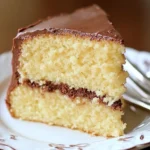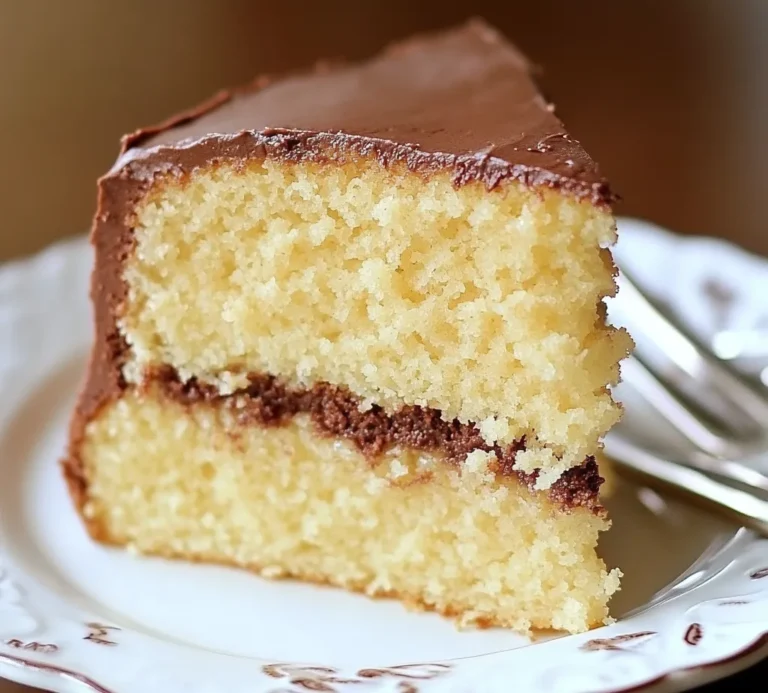Introduction: The Old-Fashioned Butter Cake is a classic dessert known for its simple, rich, and buttery flavor. This cake brings back the nostalgic taste of homemade desserts that many of us grew up with, using basic ingredients that are likely already in your kitchen. Whether you’re serving it plain or dressing it up with frosting or fruits, this timeless cake is perfect for any occasion. Its soft, moist texture and buttery taste make it an all-time favorite that pairs well with a variety of flavors.
Overview of the Recipe: This Old-Fashioned Butter Cake is a straightforward recipe that requires only a few staple ingredients like sugar, flour, butter, milk, eggs, and vanilla. The cake is mixed, baked, and ready to enjoy in under an hour. It can be served plain for a simple treat or paired with your favorite toppings, such as whipped cream or fresh berries, to elevate its flavor.
History and Origin:
The origins of butter cakes can be traced back to the early 18th century in Europe, where butter began to replace other fats in cake recipes, giving birth to the rich, tender cakes we know today. Butter cakes became especially popular in American baking in the 19th and early 20th centuries, coinciding with the invention of baking powder, which made them even easier to bake at home. This “old-fashioned” version likely dates back to recipes used by American homemakers in the early 1900s, who prized its simplicity and ease of preparation.
Ingredients:
- 1 1/4 cups sugar
- 1 tablespoon baking powder
- 1 teaspoon salt
- 2 cups all-purpose flour, sifted
- 1/2 cup butter, softened
- 1 cup milk
- 1 teaspoon vanilla extract
- 2 eggs
Instructions:
Step 1: Preheat the Oven
- Begin by preheating your oven to 350°F (175°C). A properly heated oven is essential for ensuring your cake bakes evenly.
- While your oven is preheating, prepare the baking pans. Grease two 8-inch round cake pans with butter or cooking spray.
- After greasing, dust them lightly with flour to prevent the cake from sticking, ensuring that your cake releases cleanly from the pans after baking. Set the pans aside.
Step 2: Mix the Dry Ingredients
- In a large mixing bowl, sift together the dry ingredients:
- 2 cups of all-purpose flour
- 1 1/4 cups of sugar
- 1 tablespoon of baking powder
- 1 teaspoon of salt
- Sifting helps incorporate air into the dry ingredients, resulting in a lighter cake texture.
Step 3: Add Wet Ingredients
- To the bowl of dry ingredients, add the following wet ingredients:
- 1/2 cup of softened butter (ensure the butter is at room temperature for easy mixing)
- 1 cup of milk
- 1 teaspoon of vanilla extract
- Using a hand mixer or stand mixer, beat the mixture on medium speed for 2 minutes. Be sure to scrape down the sides of the bowl to ensure all ingredients are fully incorporated. The mixture should be smooth, light, and creamy.
Step 4: Incorporate the Eggs
- After the wet ingredients are well-mixed, add 2 eggs to the batter.
- Beat the mixture for another 2 minutes. This step ensures the eggs are fully blended and the cake batter is light and airy.
- The batter should now be smooth and free of lumps, with a light yellow color.
Step 5: Bake the Cake
- Divide the batter evenly between the two prepared pans. Use a spatula to smooth out the tops of the batter for even baking.
- Place the pans in the preheated oven and bake for 30-35 minutes.
- To check if the cakes are done, insert a toothpick into the center of each cake. If the toothpick comes out clean, the cake is fully baked.
- Once done, remove the cakes from the oven and let them cool in the pans for 10 minutes.
- After 10 minutes, carefully turn the cakes out onto a cooling rack and let them cool completely before serving or frosting.
Serving Suggestions:
Old-Fashioned Butter Cake can be served as is, or you can elevate it with various toppings and accompaniments. Here are a few serving ideas:
- Classic Frosting: Frost the cake with a vanilla buttercream or cream cheese frosting.
- Fresh Fruits: Add sliced strawberries, raspberries, or blueberries with a dollop of whipped cream for a light and refreshing dessert.
- Powdered Sugar: For a simple and elegant finish, dust the cake with powdered sugar.
- Ice Cream: Serve a slice with a scoop of vanilla or chocolate ice cream for a comforting treat.
Pairing and Serving Suggestions:
Pair this Old-Fashioned Butter Cake with a cup of tea or coffee for a delightful afternoon treat. It also complements fruit juices, lemonade, or even a glass of cold milk. For more formal occasions, it can be paired with herbal teas or sparkling non-alcoholic drinks for a refreshing contrast to the rich butter flavor.
Variations of the Recipe:
There are many ways to customize this classic butter cake recipe to suit your preferences:
- Lemon Butter Cake: Add 2 tablespoons of fresh lemon juice and 1 tablespoon of lemon zest to the batter for a zesty twist.
- Chocolate Butter Cake: Incorporate 1/4 cup of unsweetened cocoa powder into the dry ingredients for a chocolate version.
- Marble Cake: Divide the batter in half and mix cocoa powder into one half. Swirl the chocolate and plain batters together in the pans before baking.
- Layer Cake: Use this cake as the base for a layered cake with fillings like lemon curd, fruit preserves, or chocolate ganache.
- Gluten-Free Version: Substitute the all-purpose flour with a gluten-free flour blend that includes xanthan gum for structure.
Health Benefits Notes:
While this butter cake is an indulgent treat, it does contain several ingredients that offer nutritional benefits:
- Eggs provide high-quality protein and essential vitamins such as vitamin B12 and riboflavin.
- Milk adds calcium and vitamin D, both important for maintaining bone health.
- Butter, although high in fat, offers fat-soluble vitamins such as vitamins A, D, E, and K, which are vital for various bodily functions.
To make a healthier version, you can:
- Substitute part of the butter with unsweetened applesauce to reduce fat content.
- Use whole wheat flour in place of all-purpose flour for added fiber.
- Reduce the sugar by 1/4 cup or use a natural sweetener like honey or maple syrup.
FAQs:
Q1: Can I make this cake in advance?
- Yes, you can bake the cake a day in advance and store it covered at room temperature. Alternatively, wrap it tightly in plastic wrap and store it in the fridge for up to 3 days or freeze it for up to 3 months.
Q2: Can I substitute margarine for butter in this recipe?
- Margarine can be used in place of butter, but the cake may have a slightly different texture and flavor. Butter provides a richer taste that is characteristic of this cake.
Q3: How can I make sure my cake turns out light and fluffy?
- Ensure that the butter is softened before mixing, and beat the batter for the recommended time to incorporate enough air. Sifting the dry ingredients also helps create a lighter texture.
Q4: Can I use self-rising flour instead of all-purpose flour?
- You can use self-rising flour, but be sure to omit the baking powder and salt, as self-rising flour already contains leavening agents.
Q5: How can I prevent my cake from sticking to the pan?
- Grease and flour the pans well, or use parchment paper on the bottom of the pans for easy release.
Conclusion:
The Old-Fashioned Butter Cake is a timeless dessert that is as delicious as it is simple to prepare. Its buttery richness, soft texture, and versatility make it a favorite for all occasions. Whether you enjoy it plain or with a variety of toppings, this classic cake is sure to become a go-to recipe in your kitchen.
Print
Old-Fashioned Butter Cake Recipe
Ingredients
- 1 1/4 cups sugar
- 1 tablespoon baking powder
- 1 teaspoon salt
- 2 cups all-purpose flour, sifted
- 1/2 cup butter, softened
- 1 cup milk
- 1 teaspoon vanilla extract
- 2 eggs
Instructions
Step 1: Preheat the Oven
- Begin by preheating your oven to 350°F (175°C). A properly heated oven is essential for ensuring your cake bakes evenly.
- While your oven is preheating, prepare the baking pans. Grease two 8-inch round cake pans with butter or cooking spray.
- After greasing, dust them lightly with flour to prevent the cake from sticking, ensuring that your cake releases cleanly from the pans after baking. Set the pans aside.
Step 2: Mix the Dry Ingredients
- In a large mixing bowl, sift together the dry ingredients:
- 2 cups of all-purpose flour
- 1 1/4 cups of sugar
- 1 tablespoon of baking powder
- 1 teaspoon of salt
- Sifting helps incorporate air into the dry ingredients, resulting in a lighter cake texture.
Step 3: Add Wet Ingredients
- To the bowl of dry ingredients, add the following wet ingredients:
- 1/2 cup of softened butter (ensure the butter is at room temperature for easy mixing)
- 1 cup of milk
- 1 teaspoon of vanilla extract
- Using a hand mixer or stand mixer, beat the mixture on medium speed for 2 minutes. Be sure to scrape down the sides of the bowl to ensure all ingredients are fully incorporated. The mixture should be smooth, light, and creamy.
Step 4: Incorporate the Eggs
- After the wet ingredients are well-mixed, add 2 eggs to the batter.
- Beat the mixture for another 2 minutes. This step ensures the eggs are fully blended and the cake batter is light and airy.
- The batter should now be smooth and free of lumps, with a light yellow color.
Step 5: Bake the Cake
- Divide the batter evenly between the two prepared pans. Use a spatula to smooth out the tops of the batter for even baking.
- Place the pans in the preheated oven and bake for 30-35 minutes.
- To check if the cakes are done, insert a toothpick into the center of each cake. If the toothpick comes out clean, the cake is fully baked.
- Once done, remove the cakes from the oven and let them cool in the pans for 10 minutes.
- After 10 minutes, carefully turn the cakes out onto a cooling rack and let them cool completely before serving or frosting.

